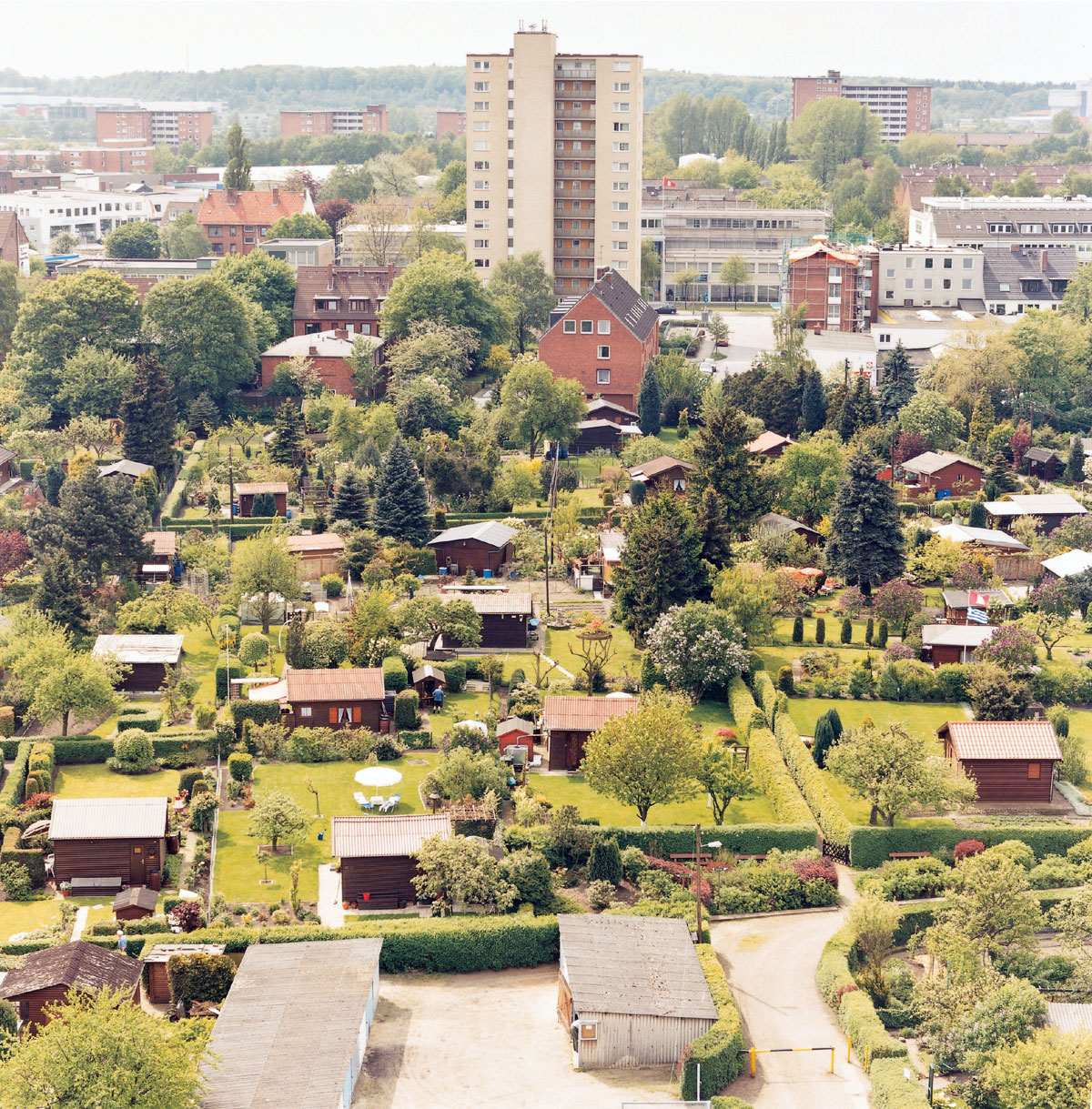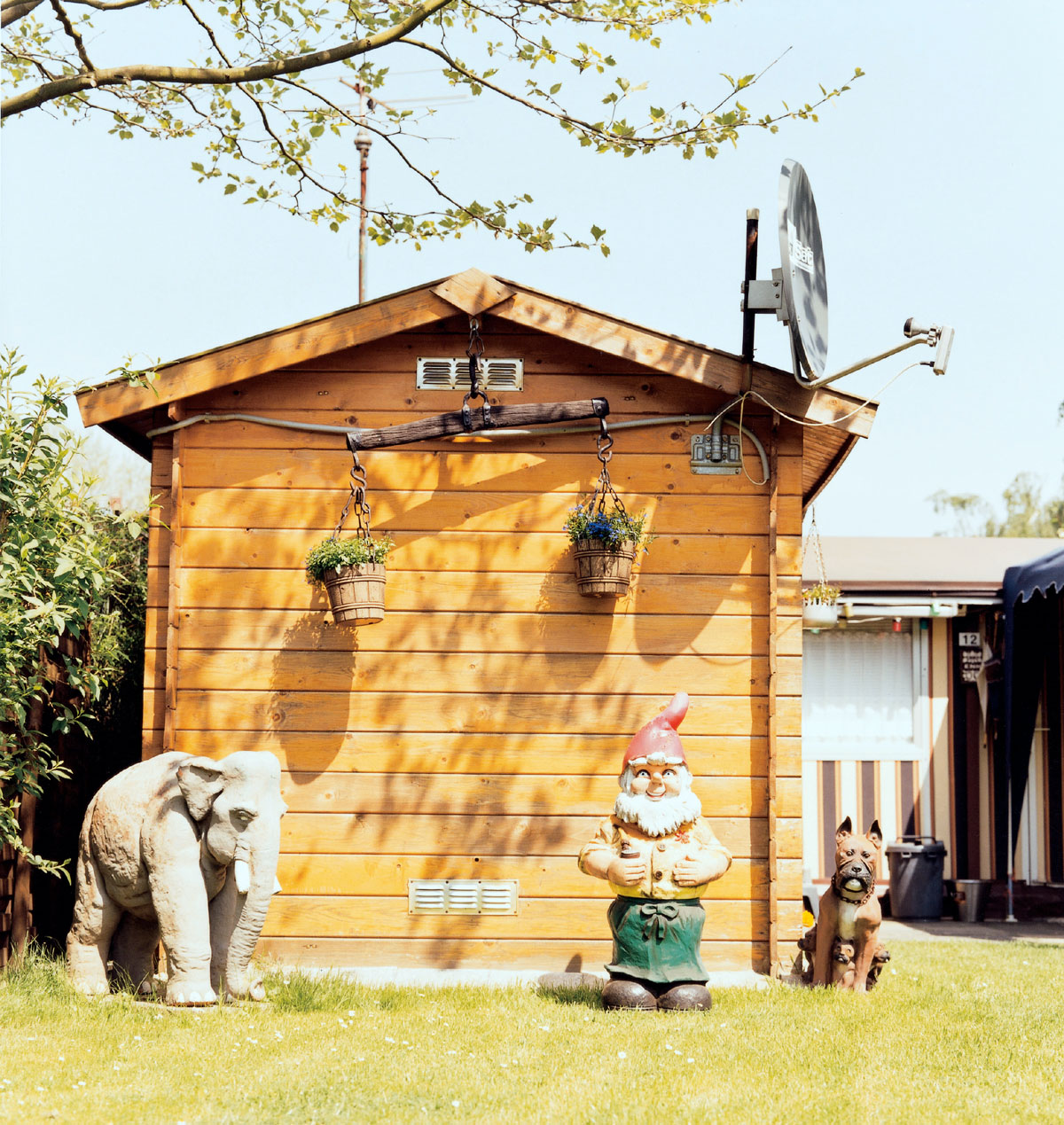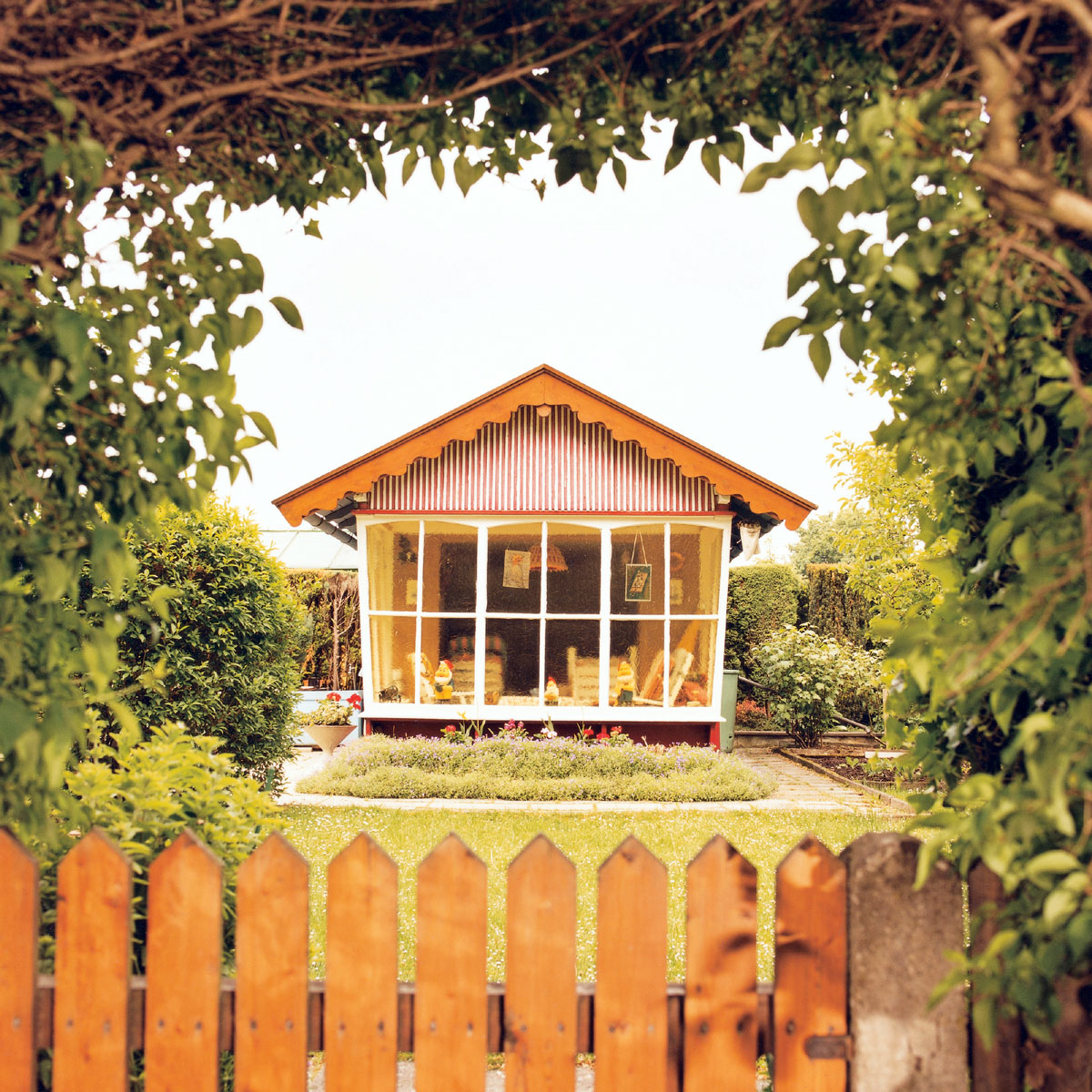The Schreber Garden
The green oasis for city dwellers
Jan Turowski

Today in Germany there are more than one million Schreber gardens (Schrebergärten), small, rented plots of land (200–400 sq meters) usually found on the outskirts of towns, used for growing fruits and vegetables or simply for relaxation. The naïve aesthetic of these gardens often functions as the self-conscious, petty bourgeois equivalent of the high culture of the great parks, the layout of the gardens evoking amateur craftsmanship and the proud celebration of kitsch. Thus one finds in many Schreber gardens the obligatory garden gnome, all manner of animal figures such as deer and frogs, stylistic varieties of miniaturized palaces, castles, windmills, and diverse farm ornaments like milk pitchers, rakes, scythes, and wagon wheels. Lots are put together to form garden colonies that are a solid feature of the German cityscape, while also providing a defiant counterimage to the urban skyline.
It is no surprise that the educated classes view them with skepticism and condescension, and see in the Schreber gardener the embodiment of the caricature of the “little man,” turned into a literary monument by Hans Fallada in his 1933 novel Little Man—What Now? For the Schreber gardener, however, this plot of land is a private refuge removed from the thoroughly subservient, regimented workaday world, a place where he can live it up on the island of personal taste that is his garden. It is at once a claim on freedom, a seemingly rural idyll in an anonymous city, a healthy oasis of comfort, and a kind of sentimental home. This freedom is illusory, however: a tight network of fences and a tight network of rules control these sites of social leisure. Federal laws regulate the size, use, and leasing of the gardens, and there are Schreber Garden Associations across Germany.
Occasionally claims are made within the Schreber garden movement that these gardens are the most prototypical expression of the essence of Germany. However, such claims obscure the fact that Schreber gardens are folk-cultural remnants of a long, contradictory, and multilayered social history in which one finds almost every movement, error, and aberration in German history.
The Schreber garden originated in the 1860s as a rather coincidental by-product of the desire to care for and educate the bourgeois youth of Leipzig. In 1864, an educational association was founded there to encourage “supervised outdoor games for children.” More or less arbitrarily, the group chose to name their association in honor of the recently deceased “excellent medical pedagogue,” Daniel Gottlob Moritz Schreber (1808–1861). Schreber, whose closest equivalent in the US is W. K. Kellogg, was a physician and the director of an orthopedic clinic in Leipzig. Obsessed with the starry-eyed goal of improving the physical and moral health of people, he was actively involved in the founding of a gymnastics and exercise club, wrote a bestseller about exercising at home and less successful books about raising children. His educational writings took positions that were progressive for his time, such as warning against a one-sided intellectual education and calling for large playgrounds that were to be overseen by gym teachers and military personnel. Most importantly, however, Schreber developed in his writings horribly tyrannical educational methods and invented several macabre devices such as the Geradehalter, which prevented children from leaning forward while writing.[1]
Several years after its founding, the Schreber Association in Leipzig planted small flowerbeds for children at the edge of a playground. These flowers only started blooming when the children’s parents tended to them and soon became known as Schreber gardens. From these “family flowerbeds” the Schreber clubs in Leipzig gradually grew into Schreber garden clubs by 1870. By the 1930s, the middle-class Schreber clubs in Leipzig had become the stronghold of a conservative worldview. Military patriotism, nature mysticism—and, later, populist nationalism and “blood-and-soil” ideology—easily took root in this milieu.
The historic development of similar garden plots in Berlin was completely different, however. Here, it was less educational ideals than economic and social forces brought about by industrialization and the resulting growth of cities that were the determining factors. The rapidly moving industrial revolution triggered an enormous internal population shift and increased emigration from the country. Within only a few decades Berlin was transformed into a Moloch, the biggest tenement city in the world and a focal point of social problems.

The “summerhouse colonies” (Laubenkolonien), as Berlin’s version of these garden plots are still called, are an expression of the poverty and misery of those involved. Beginning in the 1870s, summerhouse colonies shot up out of nowhere. In order to flee deplorable social conditions, proletarian families—many originally migrants from the country—took the initiative to build summerhouses on empty grounds recently bought up by agrarian societies, communes, or individuals. These plots had been purchased as future real-estate investments and had remained barren while waiting for Berlin to expand to its outskirts. Early on, small gardens or flowerbeds were laid out around the summerhouses and fences were built. The cultivation of fruits and vegetables could partly improve the gardener’s financial situation and help to fill hungry stomachs. Yet since no one knew how long one could keep the garden, only the most necessary investments were made. The exploitation of the working classes in the factories and tenements continued in the leasing of these plots for exorbitant prices and in the arbitrary rescinding of rights to the landowners. And the gardeners’ sympathy for socialist movements brought increased police activity, night raids, and a tightening of legal requirements, such as prohibiting assembly in the colonies.
Around the turn of the century, so-called “worker gardens” were developed to counter the increasing politicization of the “wild” small-time gardeners and to discourage them from associating with political parties and workers’ organizations. Through offering ownership, these worker gardens were intended to integrate the workers more firmly into society. These sponsored worker gardens—such as those founded in 1901 by the Fatherland Women’s Society (Vaterländischer Frauenverein), an organization of the Red Cross under the patronage of the empress—offered gardens to selected worker families for only five marks per year, with seeds at reduced cost. The ladies of the Fatherland Women’s Society were even bound by rules to discreetly observe family conditions in order to “ease undeserved misery.” One can safely assume that the majority of the families were not pleased about these discreet observations.
Even if the motivations for such bourgeois charitable organizations were Christian brotherly love and a bad conscience, it was equally important for them to de-politicize, divide, and therefore weaken the workers’ movement through authoritarian measures. The majority of the workers were therefore skeptical of these organizations. Already at that time, one can find the assessment by the workforce that the bourgeois organizations’ efforts are “much more about calculated goodwill in order to honor dynastic goals and to support capitalist interests.”[2]
There was also a middle-class, non-materialistic movement in Berlin—completely different from the one in Leipzig—that led to the founding of Schreber-style garden plots: This “life reform” movement, whose members were drawn mainly from the educated classes, was also a reaction to industrialization and urbanization. Its members spoke out against the deplorable state of affairs in the cities and against the separation from a natural way of life. These conditions were thought to lead to health problems and an increasing “depravity of manners and morals,” and so the movement fought alcohol, tobacco, and food abuse. The life reformers propagated the ideals of a healthy lifestyle, a self-sufficient communal society, and a return to a simple, moral, and moderate existence.
A wide range of political and ideological positions, ranging from socialist and anarchist to nationalist and anti-Semitic, crystallized in the life reform movement during the last decade of the 19th century. Concern with medical and hygiene standards resulted in natural healing practices, vegetarianism, nudist culture, and clothing reform. There were also socio-political reform efforts that lead to the founding of agrarian societies, the garden-city movement, utopian “new communities,” and, indeed, the establishment of garden plots.
At the beginning of the 20th century, Schreber gardeners organized themselves to effectively represent their interests. The contradiction between the proletarian-influenced wing of the garden-plot movement and the more patriarchal and civic-minded wing remained intact, resulting in diverse and contrasting groups. Nevertheless, the distinction between the two halves slowly and continuously disappeared, and in 1921 all original and political positions were relinquished as the separate affiliations were merged.

Also crucial to the de-politicization of the garden plot associations were the general political and social changes that accompanied the revolution of 1918, which eventually brought about a reform of land rights and the first German Schreber garden law. The central element of the law was the protection of renters against wrongful dismissal and, at last, a binding definition of “garden plot.”
Despite their de-politicization, Schreber gardeners continued to maintain a maverick position in society and the garden colonies remained suspicious to authorities because of the difficulty they posed for surveillance. Although the Third Reich specifically integrated the garden plot movement into their “blood-and-soil” ideology and brought the Schreber associations into line immediately after seizing power, the National Socialists mistrusted the settlements—as did the rulers of the German Democratic Republic. The uncontrollability of the garden plot colonies was what made the totalitarian state authorities so nervous. A number of Jews, for example, survived persecution by hiding in Schreber gardens, where they not only escaped the National Socialists, but also had access to food. The most famous example was Hans Rosenthal, who was later to become a TV quiz-show host.
After World War II, Schreber gardens once again took on an existential significance in the damaged cities. Every available patch of land was put to use for the raising of fruit and vegetables. The summerhouses in the garden plots were also used as temporary housing by bombed-out city dwellers. The interest in garden lands subsided with the general improvement of the economic situation. At the end of the postwar reconstruction in the mid-1960s, the significance of the Schreber garden as a source of produce as well as a social structure diminished profoundly. The classic worker culture changed noticeably; the educated classes frequently moved to the countryside and became interested in new “stimulating” political projects; mass tourism invented new ways of escaping the monotony of everyday life and the dreariness of the city. And thanks to the blessings of the welfare state, even the socially excluded were no longer dependent on the self-harvested produce of the garden plots.
Today, the lower-middle classes (skilled workers, low-level officials, and office workers) make up what is by far the largest portion of Schreber gardeners. They and their colony names (“New Life,” “Joy of Life,” “Coziness,” etc.) still hang on proudly to the dreams and goals of the garden plot movement, even if the social reality around them is radically changing. When necessary, today’s hobby gardeners defiantly resist the expansion of cities as much as they deliberately keep out of their settlements everything unpleasant about city reality. In defending their idylls, their little niches, their refuges, however, the conservative, apolitical Schreber gardeners occasionally mobilize, and no vote-conscious politician can afford to overlook this segment of German folk culture. In the shadow of public awareness, Schreber gardeners and middle-class aesthetic awkwardness will continue to exist for some time, even as the gardeners grow older and younger replacements become rarer.
Translated by Bianca Baader and Gregory Williams
- If his sons’ later development is any indication, such educational methods were not a total success. Gustav committed suicide and Paul, about whom Freud wrote a book, later developed a spectacular case of psychosis where he thought God was trying to impregnate him by sending the sun’s rays into his anus.
- Otto Albrecht, Kleingartenwesen, Kleingartenbewegung und Kleingartenpolitik (Berlin, 1924).
Jan Turowski is a political scientist and works as a freelance journalist and writer. He lives in Berlin.
Spotted an error? Email us at corrections at cabinetmagazine dot org.
If you’ve enjoyed the free articles that we offer on our site, please consider subscribing to our nonprofit magazine. You get twelve online issues and unlimited access to all our archives.